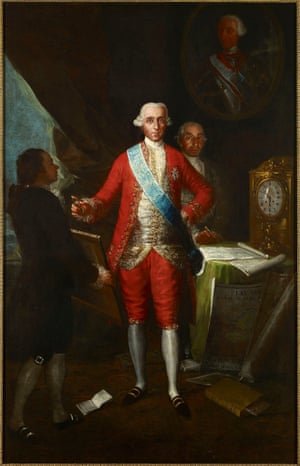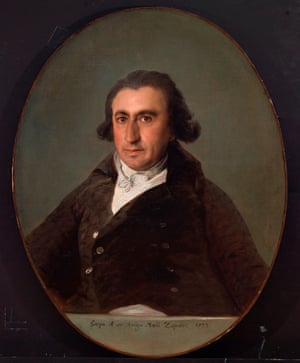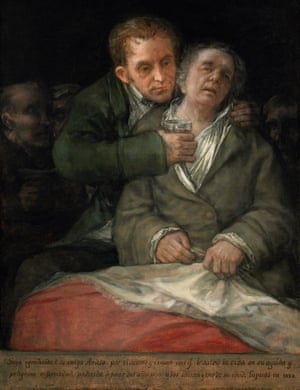
Goya’s Self-Portrait While Painting, c1795
From princes to paupers: how Goya’s portraits tell the story of Spain
Whether depicting ugly royalty or the poor of Madrid, Goya painted the person first and their position second. The first major UK exhibition of his portraits celebrates the artist who captured a nation’s history, traumas and traditions through the faces of its people
Michael Prodger
Saturday 26 September 2015
There are, according to current scholarship, 160 existing portraits by Francisco de Goya – about a third of his painted output. The real number, though, is much greater since there are no pure landscapes in Goya’s work, in that everything he ever painted deals with people. In the work of no other great portraitist are a nation’s people, history, traumas, folk traditions and superstitions so comprehensively and relentlessly captured. Titian, Holbein,Van Dyck and Rembrandt were superlative painters of the human face and figure but they made a distinction between their portraiture and their other work. Goya didn’t. Put his work together – the public and private paintings, the personal drawings and sketches and the unsettling and sinister etching series – and what you have is a portrait in the round of Spain itself.
His subject was a good one since Goya lived in interesting times: his lifetime (1746-1828) was a period that saw Spain pass through the ancien regime and the effects of the French Revolution, the Napoleonic wars and the restoration of the monarchy; it was ruled by a succession of authoritarian and liberal governments; and was simultaneously marked by the Enlightenment, fervent Catholicism and a widespread belief in the supernatural. Goya went from provincial obscurity to the Madrid court and later self-imposed exile in Bordeaux. And aged 46 he went deaf: as Spain entered its most cacophonic period he couldn’t hear what was going on around him, only see.
People were the constant during these unstable times and he recorded both the faces of those who mattered to Spain and to him – often they were one and the same. The new exhibition at the National Gallery, Goya: the Portraits, is the first major UK show to look at his portraits alone. As with Rembrandt, the demotion of previously bona fide works (including, in preparation for this exhibition, perhaps the National’s own Doña Isabel Porcel) has meant whittling down numbers but, because some 70 works will be gathered together, this show gives a chance not just to trace Goya’s development but examine in depth the types of people he painted and how he painted them.

Manuel Osorio Manrique de Zuñiga, 1788, aka The Boy in RedWhether depicting ugly royalty or the poor of Madrid, Goya painted the person first and their position second. The first major UK exhibition of his portraits celebrates the artist who captured a nation’s history, traumas and traditions through the faces of its people
Michael Prodger
Saturday 26 September 2015
There are, according to current scholarship, 160 existing portraits by Francisco de Goya – about a third of his painted output. The real number, though, is much greater since there are no pure landscapes in Goya’s work, in that everything he ever painted deals with people. In the work of no other great portraitist are a nation’s people, history, traumas, folk traditions and superstitions so comprehensively and relentlessly captured. Titian, Holbein,Van Dyck and Rembrandt were superlative painters of the human face and figure but they made a distinction between their portraiture and their other work. Goya didn’t. Put his work together – the public and private paintings, the personal drawings and sketches and the unsettling and sinister etching series – and what you have is a portrait in the round of Spain itself.
His subject was a good one since Goya lived in interesting times: his lifetime (1746-1828) was a period that saw Spain pass through the ancien regime and the effects of the French Revolution, the Napoleonic wars and the restoration of the monarchy; it was ruled by a succession of authoritarian and liberal governments; and was simultaneously marked by the Enlightenment, fervent Catholicism and a widespread belief in the supernatural. Goya went from provincial obscurity to the Madrid court and later self-imposed exile in Bordeaux. And aged 46 he went deaf: as Spain entered its most cacophonic period he couldn’t hear what was going on around him, only see.
People were the constant during these unstable times and he recorded both the faces of those who mattered to Spain and to him – often they were one and the same. The new exhibition at the National Gallery, Goya: the Portraits, is the first major UK show to look at his portraits alone. As with Rembrandt, the demotion of previously bona fide works (including, in preparation for this exhibition, perhaps the National’s own Doña Isabel Porcel) has meant whittling down numbers but, because some 70 works will be gathered together, this show gives a chance not just to trace Goya’s development but examine in depth the types of people he painted and how he painted them.

The organisers are pitching Goya as the “father of the psychological portrait”, a difficult claim to prove, especially in the light of his statement: “I have had three masters, Nature, Velázquez, and Rembrandt.” Add in Titian, whose works he saw in the royal collection in Madrid, and Goya joins a very select group rather than standing on his own. Psychology in portraiture is in the eye of the beholder but in his etchings, forLos Caprichos, for example – showing folly, witchcraft and superstitions – it is at the very heart of the matter.
Goya was 37 by the time he painted anyone’s face other than his own. Prior to that he had been a painter of religious scenes around his home city of Zaragoza (at the Charterhouse of Aula Dei outside the city and in the imposing Basilica of Our Lady of the Pillar) and then scenes of everyday life for the Royal Tapestry Factory in Madrid. Although he studied under José Luzán and later Francisco Bayeu, who became his brother-in-law in 1773 when he married Josefa “Pepa” Bayeu, Goya remained largely self-taught. In the 1760s he tried twice to be accepted into the Royal Academy of Fine Art but was rejected (the first time receiving no votes at all from the academicians), and so to further his artistic education he self-funded a two-year visit to Italy.
His work as a portraitist has its origins in the 45 tapestry cartoons he painted after he moved to Madrid in 1775. Although his designs don’t show portraits, they do show types – the majos and majas who gave Madrid its street swagger, peasants and rich men, courting couples, singers, hunters, children, and young men and women playing blind man’s buff or tossing a mannequin into the air. The pictures have a light, rococo palette and the faces are individualised without being those of individuals. But in them Goya practised poses and groupings and a way of handling light on and around figures that was to be invaluable.
The tapestry designs also show social roles rather than the people inhabiting them, but when it came to painting portraits proper, Goya would turn this on its head. His greatest strength as a portraitist is that regardless of the status of the sitter, be they a king and queen, the Duke of Wellington or a doctor or writer, it was the person he showed first and their position second. It was this trait, most apparent in his royal portraiture, that has led him to be seen as satirising the Bourbon monarchy rather than as a painter who depicted what he saw without showing obeisance to the usual flattering conventions. In Robert Hughes’s phrase, he did not “pay reflexive homage to authority” but instead walked a fine line between respect and truth.

The Count of Floridablanca, 1783
In 1780 Goya was finally elected a member of the Academy and when his first portrait commissions arrived they came from the nobility. In 1783 he painted the Count of Floridablanca, the reforming first minister of Charles III and, in 1784, his breakthrough work, The Family of the Infante Don Luis de Borbón, which was a paean to Velázquez’s Las Meninas. Don Luis (a man, according to Casanova, “laid à faire peur” – “so ugly it was scary”) was the king’s younger brother, sent into internal exile for taking time off during a royal hunting expedition to refresh himself with prostitutes placed strategically in the woods by his entourage.
Goya painted the roué as a reformed character – an uxorious husband, gathered with key members of his 550-strong household to watch his wife María Teresa have her hair done (Don Luis’s first prospective bride, the king’s daughter Maria Josefa, refused him on the not unreasonable grounds that he was still recovering from venereal disease). It is a candle-lit scene that pulses with intrigue: as well as the Infante (engrossed in a game of cards), his wife and their children, Goya showed himself, à la Velázquez, at his easel; a figure that might be the composer Boccherini; another – in a nice jibe – seems to be rival painter of Goya’s and a third who has been identified as María Teresa’s lover. For a first full essay in group portraiture it is remarkably daring, both in its technical accomplishment and in the strange and charged mise-en-scéne it depicts.

Martín Zapate, 1797
Goya’s success was rapid; in 1785 he was made deputy director of painting at the Royal Academy (his main message to his students was subversive – “there are no rules in painting”) and in 1786 became pintor de cámara, required to paint “works required for royal service”. He immediately spent some of his 15,000-reales salary on a two-wheeled gig (one of only three in Madrid) which he promptly crashed on his first outing. His amour propre untouched, he wrote to his childhood friend Martín Zapater: “I have now established an enviable way of living: I do not wait on anyone in antechambers, and if anyone wants anything from me they must come to me; I have made myself more in demand and unless it is a person of rank or at the request of a friend I would do nothing for anyone …” Five years later he blew his own trumpet even more forcibly: “From the king downwards everyone knows me.”
Part of the reason for his success was that, unlike Gainsborough, for example, he did not resent portraiture as an economically necessary chore that ate away at the time he could devote to higher art. Portraiture fascinated him; it was, after all, part of that “sacred science which requires so much study” and his portraits reveal a fully engaged artist. There is hardly any repetition in his poses (to help, he drew on prints of English portraits as well as classical statuary), he worked hard to give his sitters in repose a sense of latent movement and he defined them by the careful depiction of the space around them. When it came to clothing he allowed himself extraordinary freedom, the frogging on uniforms or lace on a dress sketched in thick impasto rather than being laboriously defined. From close up such three-dimensional scumblings look out of focus but from a distance they coalesce into silks, braiding and gauze. Such varieties of technique within a painting keep the eye entertained and moving.
Shortly after the painter’s death his son Javier, the sole child of seven to survive, wrote of his father’s portraits: “Those that he did in one session are much acclaimed. He painted only in one session, sometimes lasting 10 hours, but never as the light was fading and the final touches he would apply at night, with artificial light.” A self-portrait of the early 1790s, shows exactly that, the painter silhouetted in front of his easel and wearing a metal band round his hat to hold candles to light those “final touches”.
Public success was, however, tempered by private sadness. In 1792 and 1793 he suffered a serious illness followed by a cerebral attack – described by a friend as “apoplexy” – which left him deaf. Electrotherapy treatment did not work. When in 1798 he painted the liberal statesman Gaspar Melchor de Jovellanos in an attitude borrowed from Dürer’s Melancholia, the painter’s sensitivity towards the man with the weight of Spain on his shoulders was in part reciprocal. Goya had commented on the solicitude shown to him by Jovellanos who made sure he stopped chewing when communicating with the deaf painter and used his hands clearly to gesticulate his thoughts.

Portrait of the Duchess of Alba, 1797
Deafness was no impediment, though, when in 1794 the Duchess of Alba, the highest aristocrat in the land, “barged into my studio yesterday to have her face painted”. Makeup duly applied, Goya went on to paint several portraits of her. He had already painted her husband and mother-in-law – one of the connected series of extended family commissions that mark his work. Despite rumours, there is no evidence they were lovers (nor is she the model for the Naked Maja) but rather that he was an honorary member of her household. As such he had privileged access and made many intimate sketches of her – tearing at her hair in a fit of rage, teasing her former nanny, tenderly holding her adopted black child – as well as a pair of bravura full-lengths.
One of these shows her in white and the other, which will be at the National Gallery, in black lace with a red sash, pointing to the words “Solo Goya” (“Only Goya”) written in the sand at her feet. It is a picture that gives the lie to the words of one French visitor to Madrid, who reported pantingly: “The Duchess of Alba has not a single hair on her head that does not awaken desire. Nothing on earth is as beautiful as she is …” Goya shows her not as a full-on beauty but as a somewhat imperious and physically insistent character. In her will she left numerous bequests to her servants, with one to Goya’s son.
“My work is very simple. My art reveals idealism and truth,” Goya claimed. The truth though is always more apparent than the idealism. In the most important commission of his career, for example, the portrait of Charles IV and the royal family of 1800, he eschewed entirely the grandeur of majesty to portray the assembled Bourbons as they appeared – a motley grouping (a French visitor had likened Charles and his queen Maria Luisa to a butcher and his wife) in fancy clothes. Goya may have been a political liberal but he wouldn’t have jeopardised his hard-won new position as first court painter – the first Spaniard since Velázquez to hold the role – in order to score political points at the expense of his patrons.
That his sitters didn’t regard the portrait as unflattering was evidenced by succeeding royal commissions, not least his 1815 portrait of Ferdinand VII. Ferdinand himself was physically unprepossessing, tyrannical, vicious and small-minded and that is exactly how Goya shows him. The king, however, looking in Goya’s particular mirror, saw no such characteristics staring back at him.

Self-portrait With Doctor Arrieta, 1820
The private side of Goya’s portraiture was a world away the public. The contrast between the Ferdinand portrait and the remarkable 1820 double portrait showing Goya with Dr Arrieta represents a moral version of the three ages of man – the 73-year-old painter in the throes of a debilitating illness being tended with the utmost tenderness by his doctor. If Ferdinand represents human malignity and Goya its frailty then Arrieta stands for man’s innate goodness.
While not all his portraits are successful (some have a doll-like stiffness), this is what Goya at his best could do: in the guise of representing individuals he showed, without judging, man as a universal being.
There is a macabre but appropriate coda to Goya’s story. He died in Bordeaux in 1828. In 1901, when his body was exhumed for transferral back to Spain, the skull was missing. Among the explanations suggested were that it was stolen by a phrenologist or taken by a medical student who, as an experiment, filled it with dried chickpeas which he soaked with water until they expanded and the bones broke. There is also an 1849 painting by Dionisio Fierros in the Museo de Zaragoza that purports to show the skull. What happened to it, however, remains a mystery. The painter who got inside the heads of so many others eventually lost his own.
• Goya: The Portraits is at the National Gallery, London WC2, from 7 October.









No comments:
Post a Comment